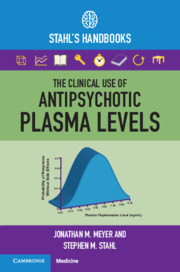Book contents
- The Clinical Use of Antipsychotic Plasma Levels
- Reviews
- The Clinical Use of Antipsychotic Plasma Levels
- Copyright page
- Half title page
- Contents
- Foreword
- Preface: How to Use This Handbook and Useful Tables for Handy Reference
- Introduction
- 1 Sampling Times for Oral and Long-Acting Injectable Agents
- 2 The Therapeutic Threshold and the Point of Futility
- 3 Level Interpretation Including Laboratory Reporting Issues, Responding to High Plasma Levels, Special Situations (Hepatic Dysfunction, Renal Dysfunction and Hemodialysis, Bariatric Surgery)
- 4 Tracking Oral Antipsychotic Adherence
- 5 What Is an Adequate Antipsychotic Trial? Using Plasma Levels to Optimize Psychiatric Response and Tolerability
- 6 Important Concepts about First-Generation Antipsychotics
- 7 Haloperidol and Haloperidol Decanoate
- 8 Fluphenazine and Fluphenazine Decanoate
- 9 Perphenazine and Perphenazine Decanoate
- 10 Zuclopenthixol and Zuclopenthixol Decanoate; Flupenthixol and Flupenthixol Decanoate
- 11 Chlorpromazine, Loxapine, Thiothixene, Trifluoperazine
- 12 Important Concepts about Second-Generation Antipsychotics
- 13 Clozapine
- 14 Risperidone Oral and Long-Acting Injectable; Paliperidone Oral and Long-Acting Injectable
- 15 Olanzapine and Olanzapine Pamoate
- 16 Aripiprazole, Aripiprazole Monohydrate, and Aripiprazole Lauroxil
- 17 Amisulpride, Asenapine, Lurasidone, Brexpiprazole, Cariprazine
- Appendix Therapeutic Threshold, Point of Futility, AGNP/ASCP Laboratory Alert Level, and Average Oral Concentration–Dose Relationships
- Index
- References
11 - Chlorpromazine, Loxapine, Thiothixene, Trifluoperazine
Published online by Cambridge University Press: 19 October 2021
- The Clinical Use of Antipsychotic Plasma Levels
- Reviews
- The Clinical Use of Antipsychotic Plasma Levels
- Copyright page
- Half title page
- Contents
- Foreword
- Preface: How to Use This Handbook and Useful Tables for Handy Reference
- Introduction
- 1 Sampling Times for Oral and Long-Acting Injectable Agents
- 2 The Therapeutic Threshold and the Point of Futility
- 3 Level Interpretation Including Laboratory Reporting Issues, Responding to High Plasma Levels, Special Situations (Hepatic Dysfunction, Renal Dysfunction and Hemodialysis, Bariatric Surgery)
- 4 Tracking Oral Antipsychotic Adherence
- 5 What Is an Adequate Antipsychotic Trial? Using Plasma Levels to Optimize Psychiatric Response and Tolerability
- 6 Important Concepts about First-Generation Antipsychotics
- 7 Haloperidol and Haloperidol Decanoate
- 8 Fluphenazine and Fluphenazine Decanoate
- 9 Perphenazine and Perphenazine Decanoate
- 10 Zuclopenthixol and Zuclopenthixol Decanoate; Flupenthixol and Flupenthixol Decanoate
- 11 Chlorpromazine, Loxapine, Thiothixene, Trifluoperazine
- 12 Important Concepts about Second-Generation Antipsychotics
- 13 Clozapine
- 14 Risperidone Oral and Long-Acting Injectable; Paliperidone Oral and Long-Acting Injectable
- 15 Olanzapine and Olanzapine Pamoate
- 16 Aripiprazole, Aripiprazole Monohydrate, and Aripiprazole Lauroxil
- 17 Amisulpride, Asenapine, Lurasidone, Brexpiprazole, Cariprazine
- Appendix Therapeutic Threshold, Point of Futility, AGNP/ASCP Laboratory Alert Level, and Average Oral Concentration–Dose Relationships
- Index
- References
Summary
As discussed in Chapter 6, first-generation antipsychotics (FGAs) are therapeutically as effective as newer antipsychotics, and their utility derives from low cost and the availability of long-acting injectable (LAI) preparations for certain agents. While there are close to 3 dozen FGAs available worldwide, many have very limited or regional use (e.g. melperone, chlorprothixene, perazine), some are rarely used (thioridazine, pimozide) due to disproportionate effects on the rate-corrected QT interval (QTc) of the EKG, and some are so poorly characterized that plasma level data is virtually nonexistent (molindone).
- Type
- Chapter
- Information
- The Clinical Use of Antipsychotic Plasma LevelsStahl's Handbooks, pp. 217 - 240Publisher: Cambridge University PressPrint publication year: 2021

